| Listing 1 - 10 of 13 | << page >> |
Sort by
|
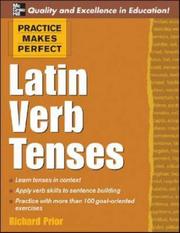
ISBN: 0071462929 9780071462921 Year: 2006 Publisher: New York McGraw-Hill
Abstract | Keywords | Export | Availability | Bookmark
 Loading...
Loading...Choose an application
- Reference Manager
- EndNote
- RefWorks (Direct export to RefWorks)
Latin language --- Tense --- Verb
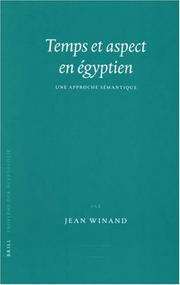
ISBN: 9004152164 9789004152168 9786611399665 1281399663 9047410041 9789047410041 Year: 2006 Volume: 25 Publisher: Leiden ; Boston : Brill,
Abstract | Keywords | Export | Availability | Bookmark
 Loading...
Loading...Choose an application
- Reference Manager
- EndNote
- RefWorks (Direct export to RefWorks)
This volume deals with the complex question of time and aspect in ancient Egyptian. The first part presents an original theoretical model which challenges some well-established facts in general linguistics. The functioning of aspect is explained as a dialectic process between the grammatical tenses, the actionality of events, the semantic roles of the participants, and diverse lexical means. The second part examines the expression of aspect in ancient Egyptian, with a diachronic presentation from the beginning down to Late Egyptian. The third and last part is devoted to the study of the temporal relation. The argumentation is illustrated by more than 800 examples and numerous figures.
Egyptian language --- Egyptien (Langue) --- Tense --- Aspect --- Temps --- Afroasiatic languages --- Egyptian language - Tense --- Egyptian language - Aspect --- Tense. --- Aspect.
Book
ISBN: 9783447053303 3447053305 Year: 2006 Publisher: Wiesbaden : Harrassowitz Verlag,
Abstract | Keywords | Export | Availability | Bookmark
 Loading...
Loading...Choose an application
- Reference Manager
- EndNote
- RefWorks (Direct export to RefWorks)
Tokharian language --- Tokharien (langue) --- Participle. --- Participe. --- Tense. --- Temps (linguistique).
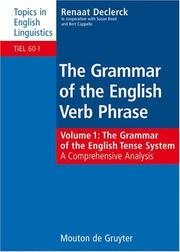
ISBN: 311018589X 9786612194931 1282194933 3110199882 9783110185898 9783110199888 9781282194939 6612194936 Year: 2006 Volume: 60.1 1 Publisher: Berlin ; New York : Mouton de Gruyter,
Abstract | Keywords | Export | Availability | Bookmark
 Loading...
Loading...Choose an application
- Reference Manager
- EndNote
- RefWorks (Direct export to RefWorks)
The Grammar of the English Tense System forms the first volume of a four-volume set, The Grammar of the English Verb Phrase. The other volumes, to appear over the next few years, will deal with mood and modality, aspect and voice. The book aims to provide a grammar of tense which can be used both as an advanced reference grammar (for example by MA-level or postgraduate students of English or linguistics) and as a scientific study which can act as a basis for and stimulus to further research. It provides not only a wealth of data but also a unique framework for the study of the English tense system, which achieves great predictive and explanatory power on the basis of a limited number of relatively simple rules. The framework provided allows for an analysis of the semantics of individual tenses which reflects the role of tenses not only in locating situations in time relative to speech time but also in relating situations in time relative to one another to form temporally coherent discourse. Attention is paid to the relations between tenses. On the one hand, we can identify sets of tenses linked to particular temporal areas such as the past or the future. These sets of tenses provide for the expression of a system of temporal relations in a stretch of discourse in which all the situations are located within the same temporal area. On the other hand, there are many contexts in which speakers might in theory choose between two or more tenses to locate a situation (e.g., when we choose between the past tense and the present perfect to locate a situation before speech time), and the book examines the difference that a choice of one or the other tense may make within a discourse context. The book moves from a detailed exploration of the meaning and use of individual tenses to a thorough analysis of the way in which tenses can be seen to function together as sets, and finally to a detailed examination of tenses in, and tenses interacting with, temporal adverbials. Original data is used frequently throughout the book to illustrate the theory discussed.
English language --- Tense --- Grammar --- 802.0-56 --- Academic collection --- 802.0-56 Engels: syntaxis; semantiek --- Engels: syntaxis; semantiek --- Tense. --- Grammar. --- Analysis and parsing --- Diagraming --- Composition and exercises --- Verb --- Germanic languages --- English language - Tense --- English language - Grammar --- English/language. --- grammar.
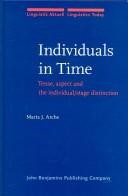
ISBN: 9027233586 9789027233585 9786612155468 1282155466 9027293341 9789027293343 9781282155466 6612155469 Year: 2006 Publisher: Amsterdam ; Philadelphia : J. Benjamins,
Abstract | Keywords | Export | Availability | Bookmark
 Loading...
Loading...Choose an application
- Reference Manager
- EndNote
- RefWorks (Direct export to RefWorks)
This monograph investigates the temporal properties of those predicates referring to individuals - the so-called individual-level (IL) predicates - in contrast to those known as stage-level (SL) predicates. Many of the traditional tenets attributed to the IL/SL dichotomy are not solidly founded, this book claims, as it examines current theoretical issues concerning the syntax/semantics interface such as the relation between semantic properties of predicates and their syntactic structure. By using the contrast found in Spanish copular clauses (ser vs. estar), Individuals in Time shows that the conception of IL predicates as permanent and stative cannot be maintained. The existence of nonstative IL predicates is demonstrated through analyzing the correlation between the syntactic presence of certain projections (specifically, prepositional complements) and process-like aspect properties. This detailed examination of IL predicates in the domains of inner aspect, outer aspect, and tense will be welcomed by scholars and students with an interest in event structure, tense, and aspect.
Grammar, Comparative and general --- Aspect. --- Tense. --- Verb phrase. --- Grammar --- Tense (Grammar) --- Aspect (Linguistics) --- Predicate (Grammar) --- Verb phrase --- Temporal constructions --- Verbal aspect --- Verb --- Phrasal verb --- Predicate --- Verbals --- Aspect --- Tense --- Linguistics --- Philology
Book
ISBN: 2708011189 9782708011182 Year: 2006 Publisher: Paris: Ophrys,
Abstract | Keywords | Export | Availability | Bookmark
 Loading...
Loading...Choose an application
- Reference Manager
- EndNote
- RefWorks (Direct export to RefWorks)
Discourse analysis, Narrative. --- French language --- Reportage literature. --- Witnesses. --- Tense. --- Definiteness. --- Linguistic studies
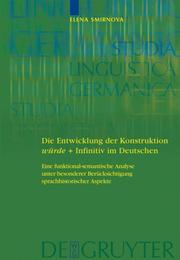
ISBN: 1282195646 9786612195648 3119161675 3110201968 9783110201963 9783110191035 3110191032 Year: 2006 Publisher: Berlin : De Gruyter,
Abstract | Keywords | Export | Availability | Bookmark
 Loading...
Loading...Choose an application
- Reference Manager
- EndNote
- RefWorks (Direct export to RefWorks)
Die Arbeit zielt auf eine systematische Beschreibung verschiedener Lesarten von würde + Infinitiv unter Berücksichtigung sowohl synchroner als auch diachroner Aspekte dieser Erscheinung. Die zentrale Hypothese ist, dass dieser Periphrase eine grundlegende semantische Basisstruktur zugrunde liegt und dass sich das Spektrum ihrer Gebrauchsweisen als je spezifische Realisierung dieser Basisstruktur darstellen lässt. Die Bedeutungsschablone ist kompositionell aus zwei Komponenten aufgebaut: das sind die evidentielle werden-Komponente und die modale Konjunktiv II-Komponente. Die unterschiedliche kontextinduzierte Realisierung dieser beiden Bedeutungskomponenten führt zur Entstehung distinktiver Lesarten von würde + Infinitiv. Auf der Grundlage der synchron erarbeiteten semantischen Basisstruktur wird die diachrone Entwicklung der Konstruktion als ein verzweigter Grammatikalisierungsprozess in seinen wichtigen Ablaufphasen beschrieben. Es wird nachgewiesen, dass das heutige Deutsch zwei distinktive Lesarten dieser Fügung mit unterschiedlichen Grammatikalisierungsgraden aufweist.Die Ergebnisse werden durch die Auswertung von zwei diachronen Textkorpora (zum Gegenwartsdeutschen und zum Frühneuhochdeutschen) untermauert.
German language --- Ashkenazic German language --- Hochdeutsch --- Judaeo-German language (German) --- Judendeutsch language --- Judeo-German language (German) --- Jüdisch-Deutsch language --- Jüdischdeutsch language --- Germanic languages --- Subjunctive. --- Tense. --- Infinitive. --- Infinitive --- Subjunctive --- Tense --- German (language, modality, language change).
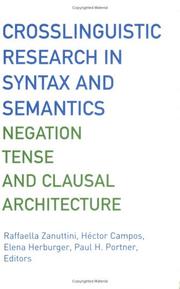
ISBN: 9781589010802 1589010809 1589013050 1435627458 9781435627451 9781589013056 Year: 2006 Volume: *1 Publisher: Washington, D.C. : Georgetown University Press,
Abstract | Keywords | Export | Availability | Bookmark
 Loading...
Loading...Choose an application
- Reference Manager
- EndNote
- RefWorks (Direct export to RefWorks)
Presenting cutting-edge research in syntax and semantics, this important volume furthers theoretical claims in generative linguistics and represents a significant addition to present scholarship in the field. Leading scholars present crosslinguistic studies dealing with clausal architecture, negation, and tense and aspect, and the issue of whether a statistical model can by itself capture the richness of human linguistic abilities. Taken together, these contributions elegantly show how theoretical tools can propel our understanding of language beyond pretheoretical descriptions, especially whe
Grammar, Comparative and general --- Semantics --- Clauses --- Negatives --- Tense --- Syntax --- Comparative grammar --- Grammar --- Grammar, Philosophical --- Grammar, Universal --- Language and languages --- Philosophical grammar --- Linguistics --- Philology --- Grammar, Comparative --- Grammar, Comparative and general - Clauses - Congresses. --- Grammar, Comparative and general - Negatives - Congresses. --- Grammar, Comparative and general - Tense - Congresses. --- Grammar, Comparative and general - Syntax - Congresses. - Semantics - Congresses. --- Grammar, Comparative and general - Semantics
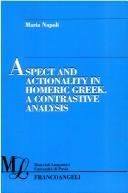
ISBN: 9788846478368 8846478363 Year: 2006 Publisher: Milano: Franco Angeli,
Abstract | Keywords | Export | Availability | Bookmark
 Loading...
Loading...Choose an application
- Reference Manager
- EndNote
- RefWorks (Direct export to RefWorks)
Indo-European languages --- Classical Greek language --- Comparative linguistics --- Grammar --- Greek language --- Tense. --- Grammar, Comparative --- Greek. --- Indo-European languages. --- Homer --- Language. --- Aryan languages --- Indo-Germanic languages --- Classical languages --- Classical philology --- Greek philology --- Grammar, Comparative&delete& --- Tense --- Greek --- Homeros --- Homère --- Homerus --- Hóiméar --- Hūmīrūs --- Gomer --- Omir --- Omer --- Omero --- Ho-ma --- Homa --- Homérosz --- האמער --- הומירוס --- הומר --- הומרוס --- هومر --- هوميروس --- 荷马 --- Ὅμηρος --- Гамэр --- Hamėr --- Омир --- Homero --- 호메로스 --- Homerosŭ --- Homērs --- Homeras --- Хомер --- ホメーロス --- ホメロス --- Гомер --- Homeri --- Hema --- Pseudo-Homer --- Pseudo Omero --- Greek language - Tense. --- Indo-European languages - Grammar, Comparative - Greek. --- Greek language - Grammar, Comparative - Indo-European languages.
Book
ISBN: 2708011308 9782708011304 Year: 2006 Publisher: Paris Ophrys
Abstract | Keywords | Export | Availability | Bookmark
 Loading...
Loading...Choose an application
- Reference Manager
- EndNote
- RefWorks (Direct export to RefWorks)
French language --- Grammar --- Français (Langue) --- Tense --- Indicative --- Temps --- Indicatif --- 804.0-56 --- Frans: syntaxis; semantiek --- Français (langue) --- français (langue) --- Indicatif. --- Temps. --- indicatif --- verbe. --- 804.0-56 Frans: syntaxis; semantiek --- Français (Langue)
| Listing 1 - 10 of 13 | << page >> |
Sort by
|

 Search
Search Feedback
Feedback About UniCat
About UniCat  Help
Help News
News